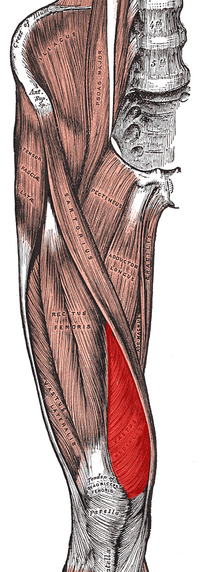Vastus Medialis Oblique: Difference between revisions
No edit summary |
No edit summary |
||
| Line 22: | Line 22: | ||
=== Nerve Supply === | === Nerve Supply === | ||
VMO | VMO receives its nerve supply from the branches of the Femoral Nerve. <ref name=":1" /> | ||
=== Bood Supply === | === Bood Supply === | ||
The femoral artery provides the blood supply for the VMO muscle. <ref>Mirjalili SA. Anatomy of the lumbar plexus. InNerves and Nerve Injuries 2015 Jan 1 (pp. 609-617). Academic Press.</ref> | |||
== References == | == References == | ||
Revision as of 07:04, 22 January 2024
This article is currently under review and may not be up to date. Please come back soon to see the finished work! (22/01/2024)
Original Editor - Rafet Irmak
Top Contributors - Admin, Ananya Bunglae Sudindar, Rafet Irmak, George Prudden, Wendy Snyders, Richard Benes, Kim Jackson, Evan Thomas, WikiSysop and Claudia Karina
Description[edit | edit source]
The Vastus Medialis Oblique (VMO) muscle is the muscle that makes up the distal most fibres of the Vastus Medialis (VM) muscle of the Quadriceps.[1] The VMO and VM muscles are functionally different due to different orientation of muscle fibres. VMO runs obliquely and helps with medial translation of the Patella where VM runs more longitudinally and contributes more to knee extension. Patellofemoral joint load is decreased by advanced and adequate medially directed force by the VMO.[2]
Origin[edit | edit source]
The VMO has multiple points of origin. The muscle fibres largely originate from the pubic points of the Adductor Magnus tendon. The other points of origin include the medial lip of linea aspera and the medial supracondylar line.[1][3]
Insertion[edit | edit source]
VMO inserts onto the medial border of the patella and the knee joint capsule. It also has a small area where it directly continues with the patella tendon[1].
Action[edit | edit source]
The primary function the VMO muscle is to pull the patella medially. The alignment of the muscle fibres, which is horizontal, makes it the primary medial stabilizer of the patella. The VMO along with Vastus Lateralis (VL) helps align the patella within the trochlear groove during knee flexion and extension.[4] The VMO also participates in the last phase of knee extension. [1]
Nerve Supply[edit | edit source]
VMO receives its nerve supply from the branches of the Femoral Nerve. [3]
Bood Supply[edit | edit source]
The femoral artery provides the blood supply for the VMO muscle. [5]
References[edit | edit source]
- ↑ 1.0 1.1 1.2 1.3 El Sawy MM, Mikkawy DM, El-Sayed SM, Desouky AM. Morphometric analysis of vastus medialis oblique muscle and its influence on anterior knee pain. Anatomy & cell biology. 2021 Mar 1;54(1):1-9.
- ↑ Peng YL, Tenan MS, Griffin L. Hip position and sex differences in motor unit firing patterns of the vastus medialis and vastus medialis oblique in healthy individuals. Journal of Applied Physiology. 2018 Jun 1;124(6):1438-46.
- ↑ 3.0 3.1 Rajput HB, Rajani SJ, Vaniya VH. Variation in morphometry of vastus medialis muscle. Journal of Clinical and Diagnostic Research: JCDR. 2017 Sep;11(9):AC01.
- ↑ Miao P, Xu Y, Pan C, Liu H, Wang C. Vastus medialis oblique and vastus lateralis activity during a double-leg semisquat with or without hip adduction in patients with patellofemoral pain syndrome. BMC musculoskeletal disorders. 2015 Dec;16(1):1-8.
- ↑ Mirjalili SA. Anatomy of the lumbar plexus. InNerves and Nerve Injuries 2015 Jan 1 (pp. 609-617). Academic Press.







